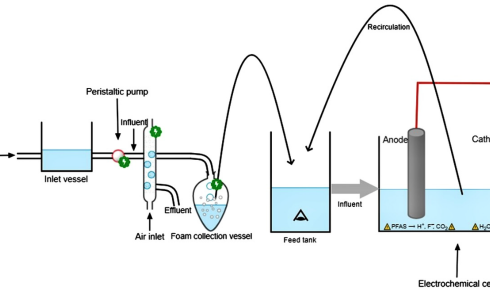Let’s be honest — most of us don’t think twice before pouring a glass of water straight from the tap. It’s supposed to be safe, right? That’s what we assume, at least. But over the past few years, stories have been popping up everywhere about “forever chemicals,” a phrase that sounds dramatic until you realize just how literal it is. These substances — known as PFAS — don’t easily break down, and they’re quietly making their way into our drinking water, our homes, and even our bodies.
What Exactly Are PFAS?
PFAS stands for per- and polyfluoroalkyl substances — a family of thousands of human-made chemicals used since the 1940s in everything from nonstick pans and waterproof jackets to firefighting foams and fast-food packaging. They’re incredibly resistant to heat, oil, and water, which makes them great for manufacturing but terrible for the environment. Once they’re out there, they linger. They don’t dissolve. They don’t decay. They just… stay.
And that’s where the trouble begins. Studies have shown that these chemicals can accumulate in the human body over time, potentially causing health issues ranging from thyroid problems and high cholesterol to more serious concerns like immune system disruption and certain types of cancer. When you start digging deeper, the issue of pfas in water becomes not just a scientific concern but a deeply personal one.
The Invisible Intruder in Your Glass
You can’t see or taste PFAS, which makes them all the more unsettling. They slip through the cracks of traditional water treatment processes, traveling through pipes and wells unnoticed. For people who rely on private wells, the problem can be even worse since regular municipal monitoring doesn’t apply there.
Imagine drinking water every day for years without realizing it’s laced with persistent industrial chemicals. That’s not a hypothetical — that’s the reality for countless communities across the United States. Towns in Michigan, New York, North Carolina, and several other states have reported contamination levels exceeding EPA guidelines. And it’s not limited to one region; PFAS have been found in groundwater, rivers, and even rain.
Why PFAS Are So Hard to Get Rid Of
Think of PFAS like glitter — once it’s out, good luck cleaning it up. Traditional water treatment systems aren’t built to capture these ultra-resistant molecules. Even advanced processes like sedimentation and chlorination barely make a dent. The chemicals are so stable that they can survive high heat and strong acids.
That’s why pfas removal requires more specialized technology. Activated carbon filters, ion exchange systems, and high-pressure membranes such as reverse osmosis are some of the most effective methods currently used. These systems physically trap or separate PFAS from the water, though they come with their own challenges — maintenance costs, disposal of contaminated materials, and scalability for large communities.
In simple terms, we can remove them, but it’s not cheap or easy. And for homeowners, that often means deciding whether to invest in filtration systems themselves or wait for local authorities to take action. Spoiler: waiting usually isn’t the best option.
Testing — The First Step Toward Safer Water
Here’s something not everyone realizes: before you can solve the problem, you have to know it exists. That’s where pfas water testing becomes crucial. Testing helps determine whether your water supply is contaminated and to what extent. It’s not as simple as dipping a strip and waiting for it to change color; PFAS testing typically involves sending samples to a certified laboratory equipped to detect ultra-low concentrations (we’re talking parts per trillion).
For households relying on private wells, testing at least once a year is recommended — especially if your home is near industrial sites, airports, or old firefighting training areas where PFAS were heavily used. It’s an upfront cost, sure, but it’s worth every penny for the peace of mind that comes with knowing what’s in your water.
Communities Fighting Back
The good news is that awareness is growing, and communities are starting to push back. Environmental groups, local governments, and even concerned citizens are demanding accountability and cleanup efforts. The U.S. Environmental Protection Agency (EPA) has begun rolling out stricter limits and cleanup mandates, though the process is slow and often tangled in bureaucracy.
Some cities have started upgrading their water treatment plants with advanced filtration systems, while others are providing residents with home filter rebates or bottled water in the interim. Meanwhile, more companies are being pressured to phase out PFAS in their manufacturing processes — a small but vital step toward preventing further contamination.
Small Changes at Home Make a Big Difference
While the global fight against PFAS continues, there are small steps individuals can take to protect their homes. Using water filters certified to reduce PFAS is one. These filters typically use activated carbon or reverse osmosis systems, which are the most effective household solutions currently available.
It’s also wise to limit products known to contain PFAS — like certain nonstick cookware, stain-resistant fabrics, and takeout packaging. Being mindful of what you buy and how it’s made can help reduce demand for these chemicals in the first place.
The Bigger Picture
The story of PFAS isn’t just about pollution — it’s about trust. We assume that what comes out of our taps is safe because it’s supposed to be. And for decades, that assumption held up. But as we’ve learned, some threats don’t announce themselves with color, smell, or taste. They hide in plain sight.
The challenge now is not only scientific but social: rebuilding confidence in the systems designed to protect us. Governments, manufacturers, and communities have to work together to ensure this problem doesn’t just fade into the background again.
Final Thoughts
Water is life — it’s as simple as that. Yet, the purity of that life source can no longer be taken for granted. Whether it’s testing your water, investing in better filtration, or simply staying informed, every step counts toward safeguarding your health and your family’s future.
Because when it comes to PFAS, ignorance isn’t bliss — it’s exposure. And while we may not be able to erase what’s already out there, we can make sure the next glass we pour is a little cleaner, a little safer, and a lot more transparent than the one before.

